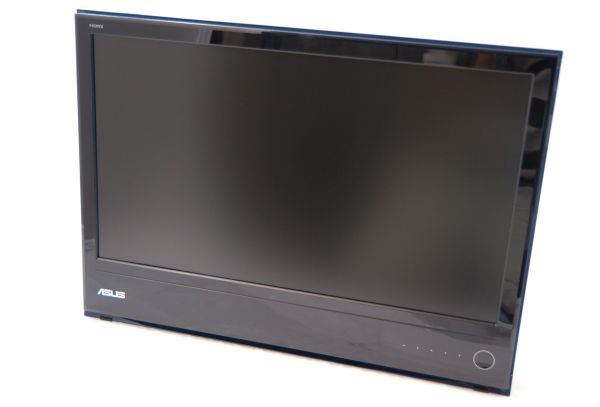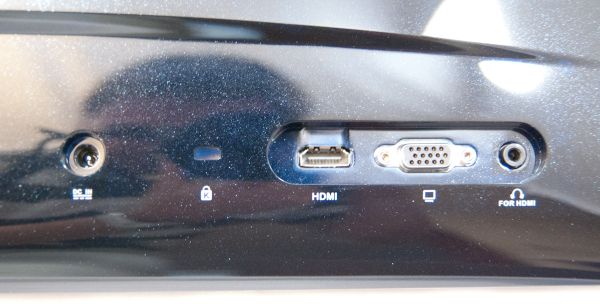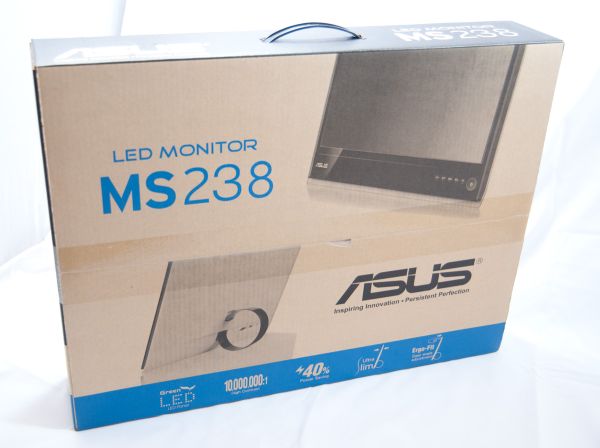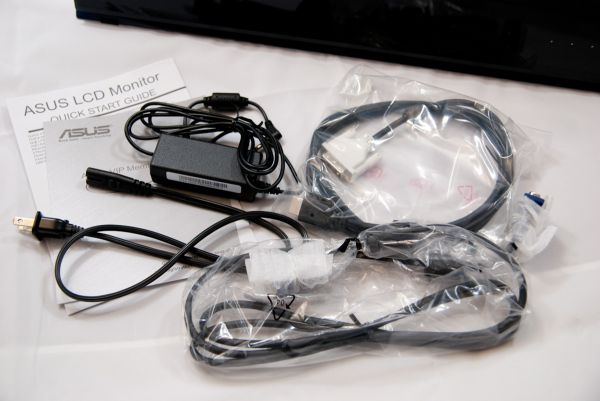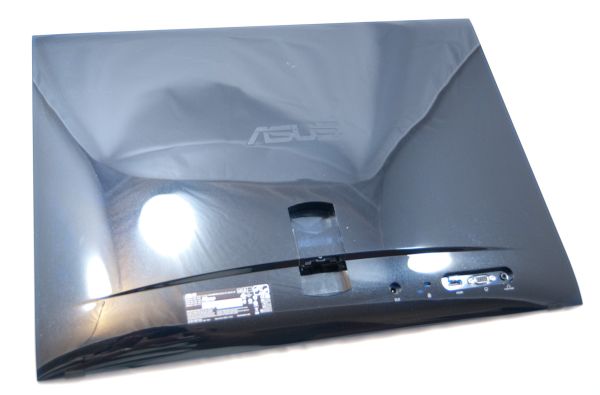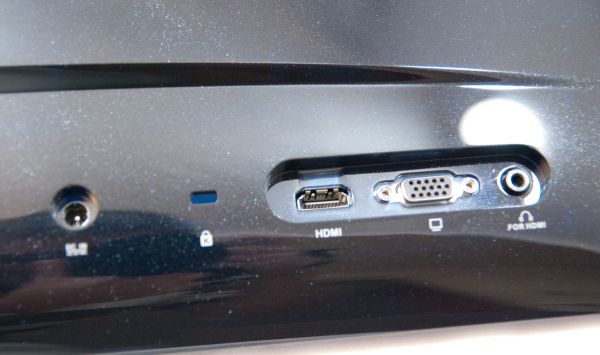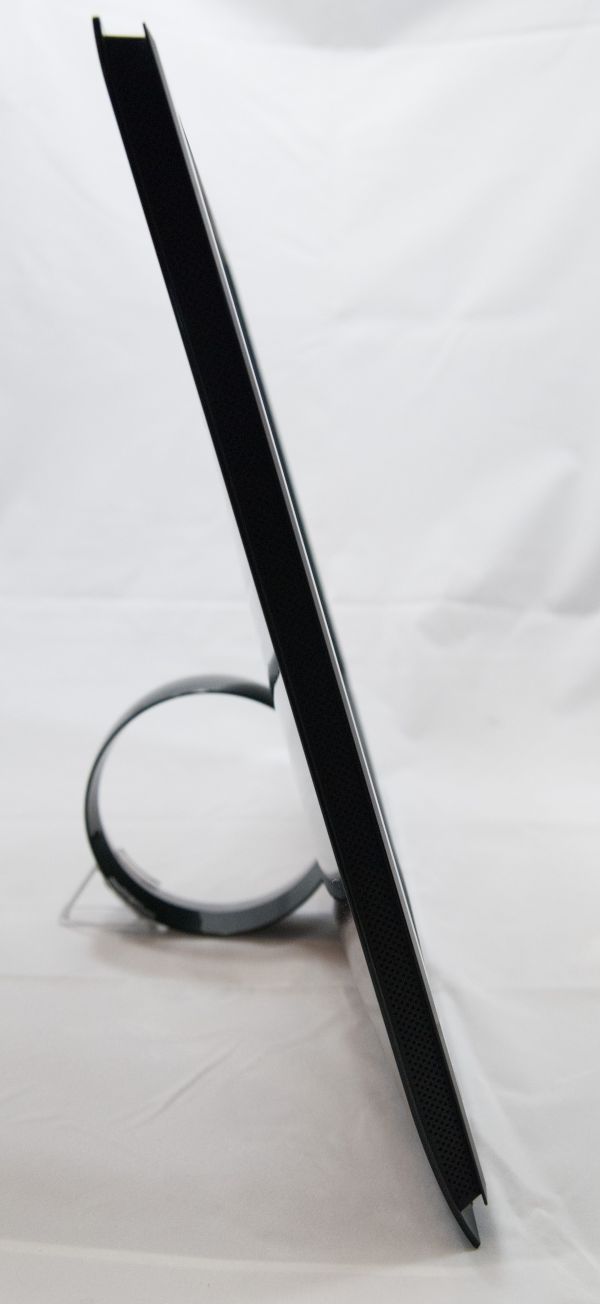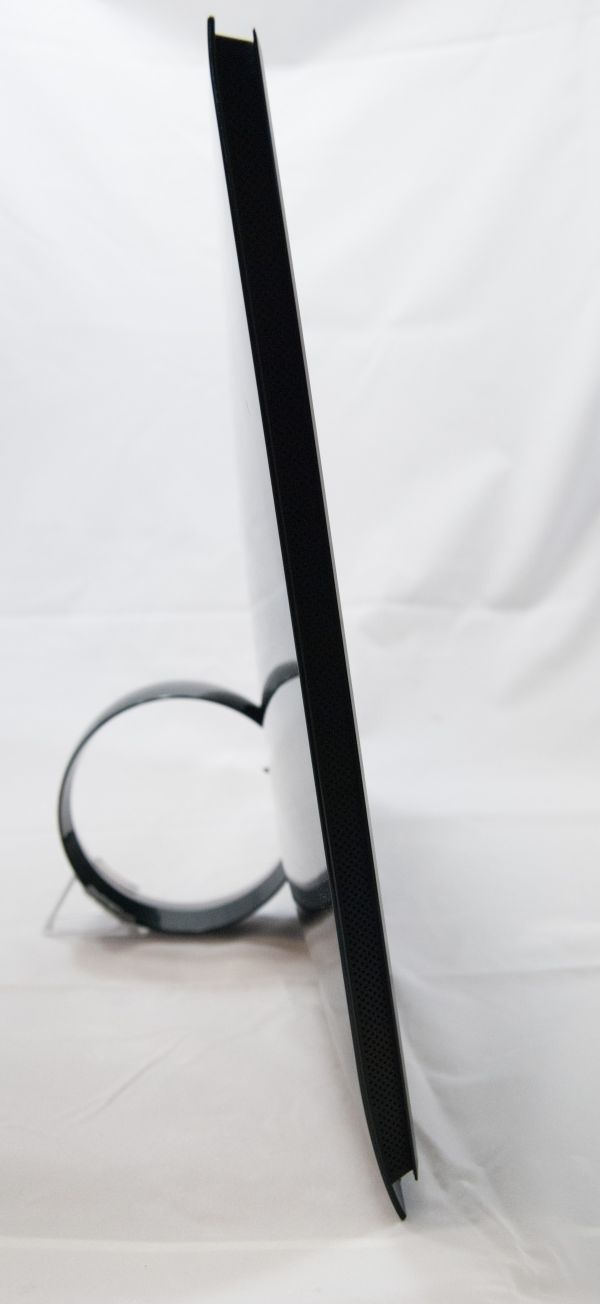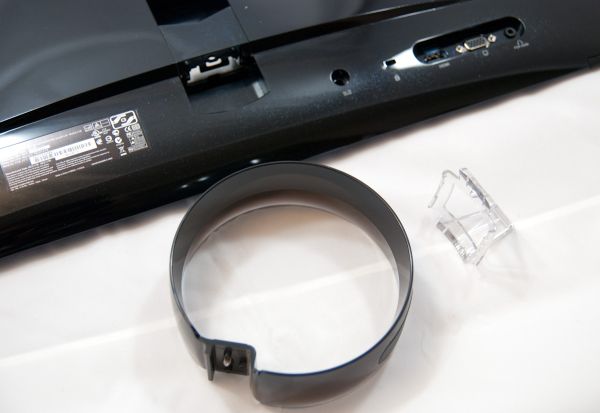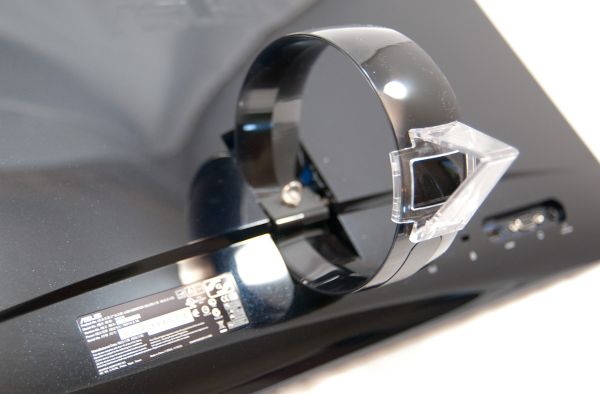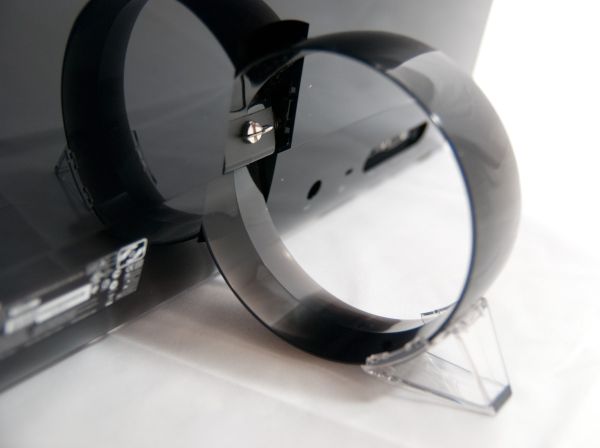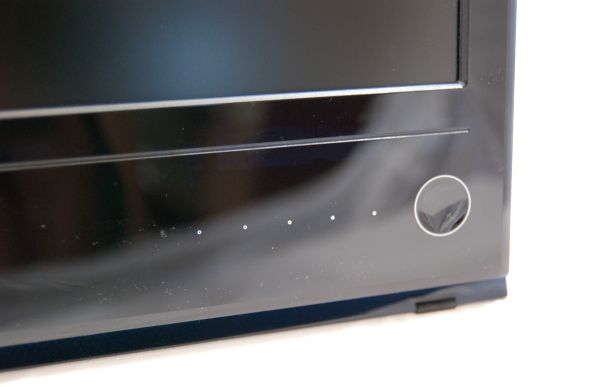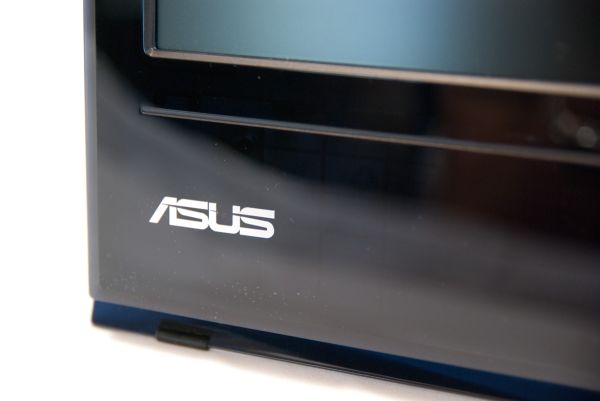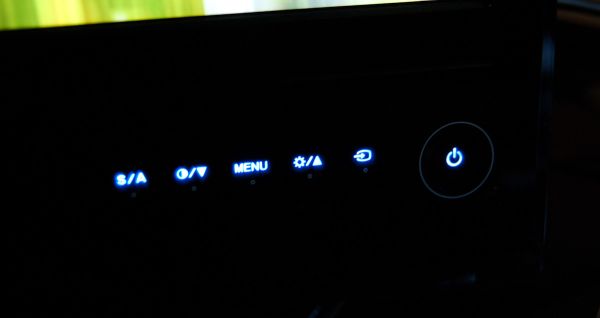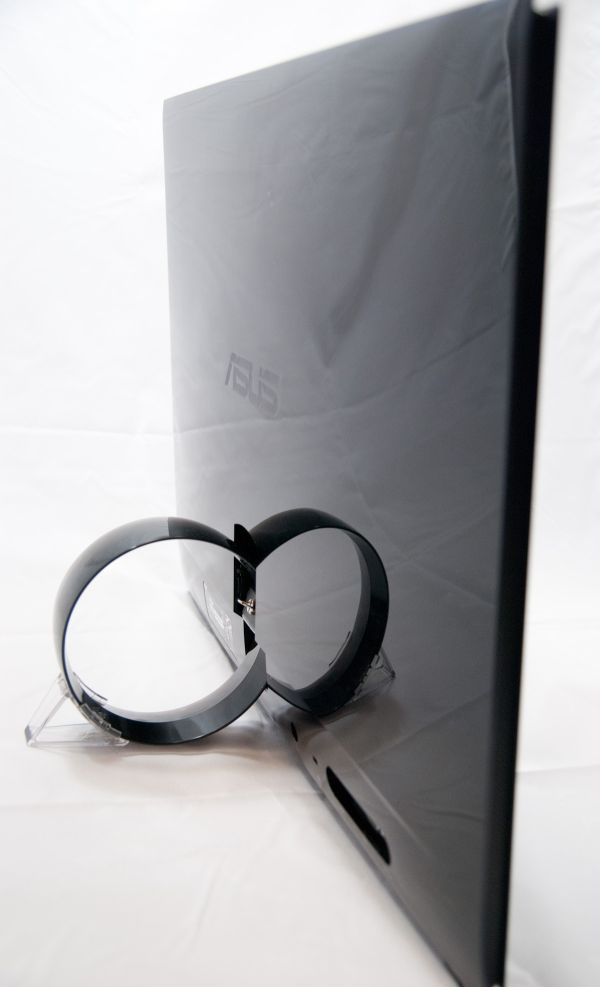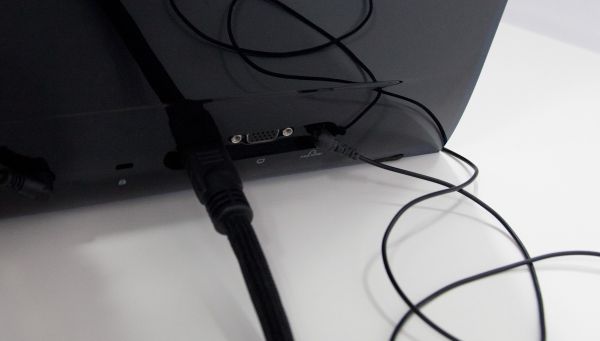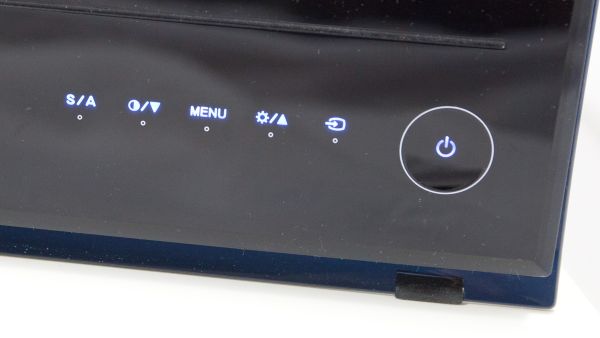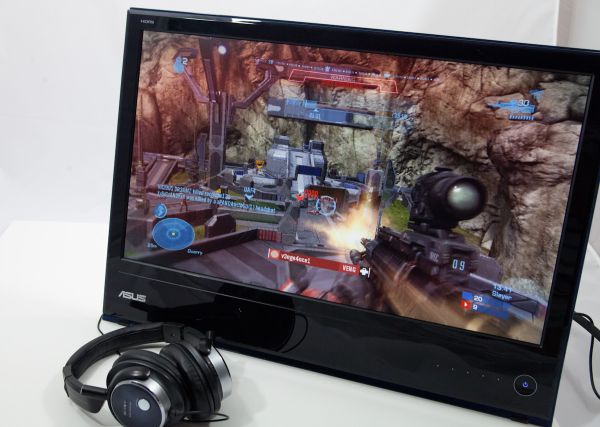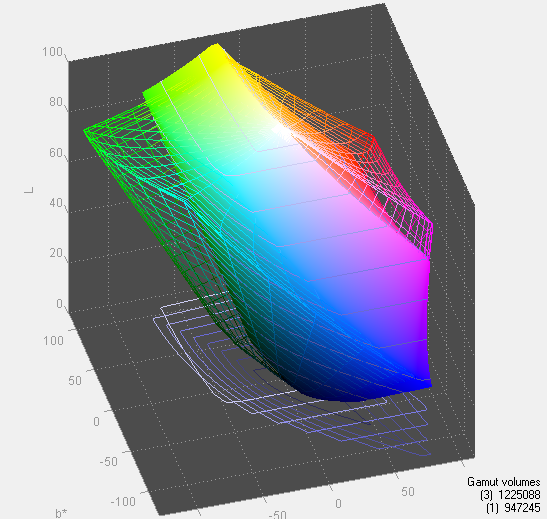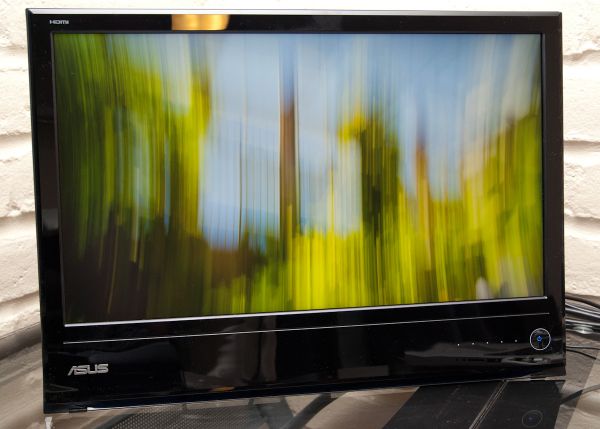
Original Link: https://www.anandtech.com/show/4001/asus-ms238h-review-slim-and-affordable
ASUS MS238H Review - Slim and Affordable
by Brian Klug on December 24, 2010 1:47 AM ESTIntroduction
So I have a confession to make. The past few months I've been incredibly preoccupied with smartphones, so much so that the ASUS MS238H has been sitting on my desk for a very long time. The data's been largely taken, the display calibrated, but for whatever reason the review has endlessly been on my back burner - I'm sorry ASUS. The upside of this situation, however, is that I've spent a long time using the ASUS MS238 and feel like I know it inside and out, and it's a slim value performer.
Let's start with the specifications. The MS238H is a 23-inch LED-backlit, TN-panel packing display with an extremely slim profile, and even slimmer budget price tag. We're used to primarily covering the high-end side of the market with IPS displays, which the MS238H definitely isn't, but that isn't to say this segment isn't worth taking a look at. The MS238H is also of the 1080P, (and thus 16:9 aspect ratio) variety, a rather disturbing trend that's all but eliminated the 1920x1200, 16:10 market. The specs are what they are, and you can find them in the table below:
| ASUS MS238H - Specifications | |||
| Property | Quoted Specification | ||
| Video Inputs | HDMI, D-Sub (DVI-D through HDMI connector) | ||
| Audio Output | 3.5mm Mini-jack for HDMI Audio | ||
| Panel Type | TN with LED Backlight | ||
| Pixel Pitch | 0.265 mm | ||
| Colors | 16.7 Million (24 BPP) | ||
| Brightness | 250 nits | ||
| Contrast Ratio | 1,000:1, or 100,000:1 (dynamic) | ||
| Response Time | 2ms (g2g) | ||
| Viewable Size | 23" (54.8 cm) diagonal | ||
| Resolution | 1920x1080 (1080P) | ||
| Viewing Angle | 170 degrees horizontal, 160 degrees vertical | ||
| Power Consumption (operation) | <33 watts typical | ||
| Power Consumption (standby) | <1 watt typical | ||
| Screen Treatment | Matte | ||
| Height-Adjustable | No | ||
| Tilt | Yes: 10 degrees - 20 degrees | ||
| Pivot | No | ||
| Swivel | No | ||
| VESA Wall Mounting | No | ||
| Dimensions w/ Base (WxHxD) | 21.9" (556 mm) x 15.9" (403.8 mm) x 5.9" (150.9 mm) | ||
| Weight w/o Stand | 8.4 lbs (3.8 kg) | ||
| Additional Features | 16.5mm thickness, kensington lock | ||
| Limited Warranty | 3 years - repair or replacement | ||
| Accessories | DVI-D to HDMI cable, VGA D-Sub cable, External Power Supply | ||
| Price | MS238H MSRP: $229.99, Amazon: $169.99 | ||
It should be pretty obvious that this display is really oriented at budget-conscious shoppers, or gamers looking for a display small and light enough to augment a notebook or portable LAN party rig. In fact, after carrying the thing to and from rooms to photograph many a time (as inevitably happens with all other displays up for review), that's really what I'm left thinking the MS238H is most suited for. It's light, it's thin, and has a headphone jack for HDMI audio, which makes it suited for periodically connecting up to a console or two.
Inputs are the only real concern on the MS238H - the two options are HDMI or D-SUB for VGA. It'd be nice to see two HDMI ports, or even HDMI and DVI-D, instead of D-SUB. What the MS238H does have going for it is that WLED backlighting, being a power-sipper, and again thin profile.
First Impressions
Let's start with initial setup. ASUS provides some classy packaging for the MS238H which carries labeling and a photo of the display on the front. It's interesting how everyone does different things with packaging for displays - some include lots of adornments, others like Dell just pack the display in a plain grey box.
In the box also are the usual quick start and warranty papers, D-Sub cable, external power supply (the MS238H doesn't have an internal power supply), and a DVI to HDMI cable.
The first thing that struck me about the display was that the material is a dark blue color with metallic flecks suspended inside. In the harsh, intense fluorescent white light inside the lightbox, it seems overpowering. On the desk or in an average lit office, the material looks a much more understated uniform black color.
On the back you get HDMI, D-SUB (VGA), DC-in, and 3.5mm ports. They're all clustered in the same general area on the bottom right, along with a Kensington lock port.
Where things get interesting is how the MS238H stands upright. There's a circular plastic piece which screws into the rear of the display, onto which clips another clear plastic piece. The ring connects to the display with a screw, and swivels around while the clear piece sits coplanar with the table.
Pushing on the display thus lets you tilt it back and forth, but only by about 10 degrees - it's a pretty limited range of motion, but surprisingly sufficient.
Attaching the ring to the display is initially a bit confusing just because it isn't something I've seen before. There's a plastic guard on the display which covers the mounting point. Before you can install the ring, the plastic cover must be removed, which basically involves prying it off out of plastic snaps. I was sure I was going to break something going at it this way, but that's the way it's done. Next you have to clip the white brace on the ring and get it squared off, but that isn't a challenge.
The tradeoff for such a simple mount is that you lose height adjustment, swivel, and get no VESA mount, but the upshot is that there's really only one piece to transport around. I did notice that the display can creep backwards and tilt into its home position, but only on extremely smooth surfaces.
It would've been nice to see some rubberized material on the bottom of that clear plastic clip which actually contacts the surface the display rests on, because it did slide over time into the most reclined position on all my glass desks.
The front of the MS238H isn't too surprising - there are 5 capacitive OSD control buttons and a capacitive power button off to the right. At far left is ASUS branding, above it is an HDMI logo. The display ships with lots of feature stickers that are easily removed, not the paper kind which leaves a huge mess. The OSD capacitive buttons lack no other markings to belie their presence but white dots. However, touching the buttons illuminates the button and reveals its purpose. The only indicator that's always on is the power symbol in its capacitive depression.
The display panel on the MS238H is matte (thankfully), however the plastic all over the monitor is a high gloss sheen. It seems like a strange choice to forego the increasingly-obligatory glossy panel but slap a glossy plastic surface on the bezel and backside. The result is that dust which bothered me most often wasn't on the surface of the display itself but rather the surrounding plastic, especially on the front bezel which shows it all the time. It's also easy to see fingerprints after you've used the OSD buttons under the right illumination. Honestly the bezel and backside seem to love static charge and attract dust unless you wipe with the right type of cloth - speaking of which, why don't LCD displays come with micro fiber cloths?
In spite of that however, the MS238H's industrial design is definitely striking and on the attractive side of the spectrum. The metallic appearance isn't tacky or gauche, and the display itself is certainly one of the thinnest and requires little surrounding surface area.
OSD and Gaming
One of the nice things about the MS238H is that the display includes a much-needed 3.5mm headphone jack for HDMI audio pass through. It's amazing how many displays include HDMI, yet provide no audio out options for when you want to connect a game console and just use HDMI. On displays without the jack, the only alternative is using old-school RCA plugs and a 3.5mm headphone jack converter, and (because I've yet to find one that has a female plug) probably a female-female headphone jack so you can actually use the connection. More and more displays are starting to carry an option for stereo out like the MS238H does, however, which is awesome.
Even better, the OSD controls include volume controls, which is incredibly welcome even if it takes at least 5 OSD selections to actually reach the volume control window. The only problem with the headphone jack on the MS238H is its location - it's on the rear which is a bit of an inconvenience if you're constantly swapping headsets or don't have a long cable. On the other hand, since there's only one HDMI jack, if you're switching from your desktop to a console constantly, you're going to have to go back there anyways.
I normally leave our OSD walkthrough until the end, but I think it's worth mentioning that the OSD controls include the right set of scaling options: full, 4:3, and overscan. There's no 1:1 explicitly provided, but if you're using HDMI chances are good you're connecting to something which drives the panel's native resolution of 1920x1080 so it's a moot point. The OSD style and majority of settings are essentially the same as I saw on the VG236H.
I can't complain about the OSD on the MS238H - it's standard ASUS fare with the appropriate changes for this particular panel. There are presets which include standard and game modes, overdrive controls under "Trace Free" (which basically gets turned on when you select game mode), dynamic contrast under "ASCR", RGB gain controls, aspect ratio, volume, and more. All in all nothing surprising or out of the ordinary.
I did find that sometimes the capacitive OSD buttons can mis-sense a press and keep sending input for a few seconds after your finger is lifted off the button. While adjusting brightness and contrast for calibration, I unintentionally sent the display to maximum and minimum a few times more than I would've liked to. After a few presses it's easy to get the hang of, but I still vastly prefer mechanical buttons. It gets frustrating fast when you're trying to nail a specific brightness or color temperature for calibration and have to tediously enter and exit menus, all while being super careful about how delicately you're touching buttons. The average end user might only dive into menus once a month or less, but it's still an occasional hit or miss experience.
Some of the button markings are confusing. The one marked S/A is a bit odd - most of the time it functions as exit or back, while menu is select and enter. I guess I find those confusing since S seems to imply Select, even though I know ASUS means "Splendid" preset settings. Tapping on the contrast symbol quickly brings up the change contrast window, and tapping the brightness button brings up brightness - the two buttons then change to down and up respectively.
I played a lot of Halo Reach on the MS238H and found the combination of headphone jack and HDMI perfectly suited for the task. My Sony MDR-NC50 headsets usually require a ton of drive power to even sound what I'd consider adequate, but sounded loud enough on the display's headset jack. I'll get to it in a moment but I couldn't detect any lag on the MS238H - if anything, the time I played on the MS238H led me to discover that my newly constructed combination of TV and A/V receiver is incredibly laggy by comparison.
Viewing Angles
First up in our objective analysis are viewing angles. We're on a TN panel here and thus shouldn't expect much in the way of excellent viewing angles, however the MS238H actually performs very well, potentially thanks in part to WLED backlighting. ASUS advertises 170 degrees horizontal and 160 degrees vertical with a 10:1 contrast ratio. That's a bit low of a cutoff contrast ratio for viewing angle consideration, but in the horizontal direction the MS238H performs very well.
Vertically we see what we're used to with TN panels and get serious color distortion when viewed from extreme angles below the display, but not much when we view it from extreme angles above.
Color Gamut
Next up are the ever-important color quality metrics. As usual, we report two main quality metrics: color accuracy (Delta-E) and color gamut. Color gamut refers to the range of colors the display is able to represent with respect to some color space. In this case, our reference is the AdobeRGB 1998 color space, which is larger than the sRGB color space. Our percentages are thus reported with respect to AdobeRGB 1998, and larger is generally better unless you're dealing with sRGB content and colorspace-unaware software.
Color accuracy (Delta E) refers to the display’s ability to display the correct color requested by the GPU and OS. The difference between the color represented by the display, and the color requested by the GPU is our Delta-E, and lower is better here. In practice, a Delta E under 1.0 is perfect - the chromatic sensitivity of the human eye is not great enough to distinguish a difference. Moving up, a Delta E of 2.0 or less is generally considered fit for use in a professional imaging environment - it isn’t perfect, but it’s hard to gauge the difference. Finally, Delta E of 4.0 and above is considered visible with the human eye. Of course, the big consideration here is frame of reference; unless you have another monitor or some print samples like a Gretag Macbeth color checker card to compare your display with, you might not notice.
As I mentioned in our earlier reviews, we’ve updated our display test bench. We’ve deprecated the Monaco Optix XR Pro colorimeter in favor of an Xrite i1D2 since there are no longer up-to-date drivers for modern platforms.
For these tests, we calibrate the display and try to obtain the best Delta-E we can get at both 200 nits of brightness for normal use, and 100 nits for print brightness. We target D65 and a gamma of 2.2, but sometimes the best performance lies at native temperature and another gamma, so we try to find what absolute absolute best-case performance for each display. We also take an uncalibrated measurement to show performance out of the box using either the manufacturer supplied color profile, or a generic one with no LUT data. For all of these, dynamic contrast is disabled, and displays are left to settle for a half hour after making changes. Of course, the MS238H is LED backlit so settling time is essentially instantaneous, as compared to CCFLs that often take a half hour or more to settle.
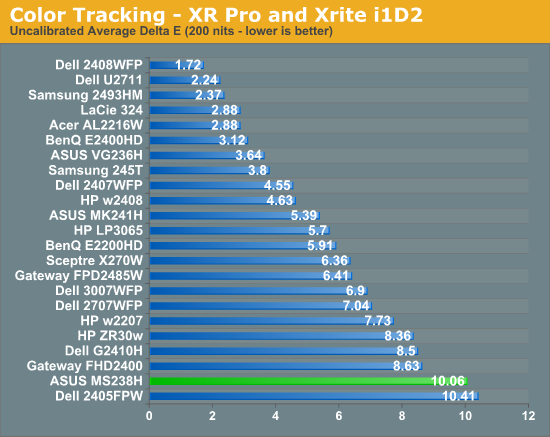
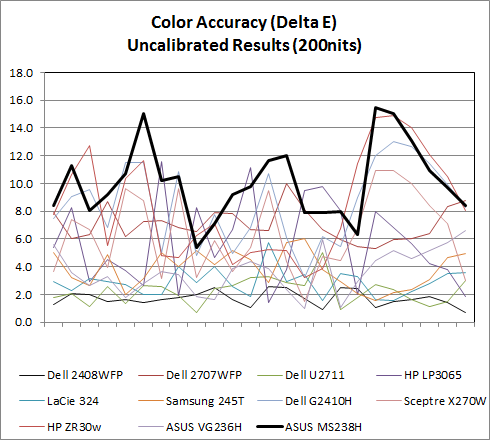
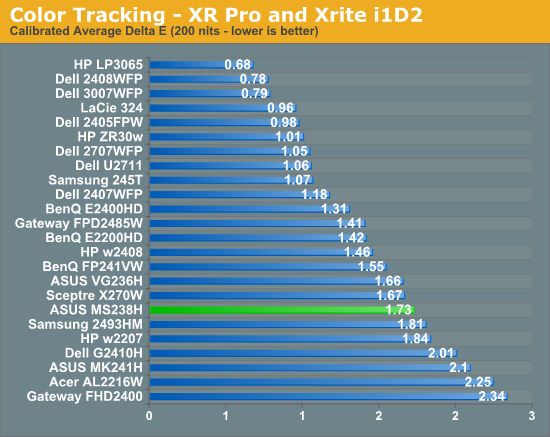
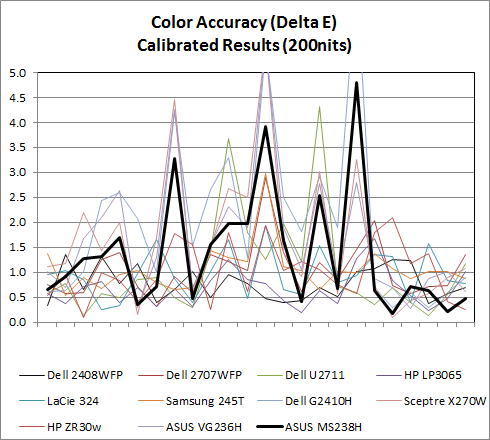
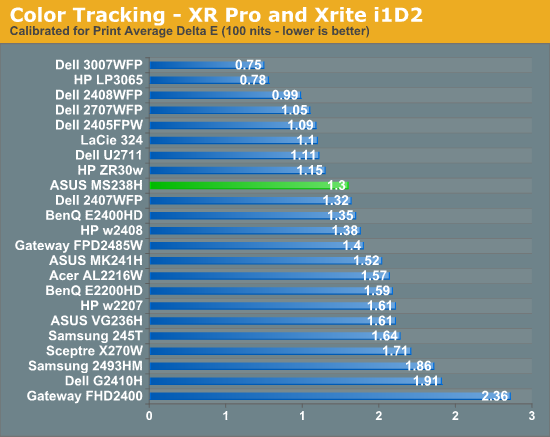
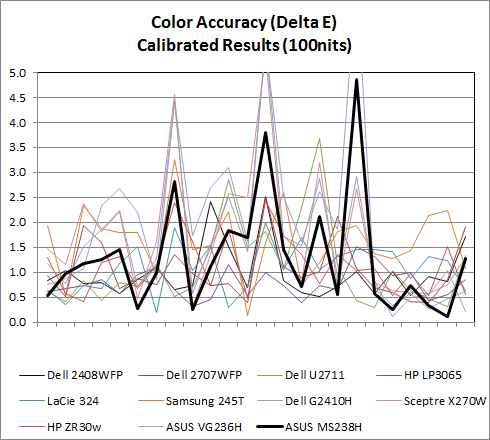
Uncalibrated and set to 200 nits, the MS238H is among the worst we've seen. Out of the box, the display is noticeably blueish. Initial measurements put white point around 7300K. After tweaking the RGB controls to nail D65, 200 nits, and a few calibration tweaks later, the MS238H actually performs pretty decent, with a Delta-E of 1.73. It's nothing stellar, but not bad considering our comparison is chock-full of IPS panels. Performance improves a bit at 100 nits, moving the MS238H almost up into IPS territory.
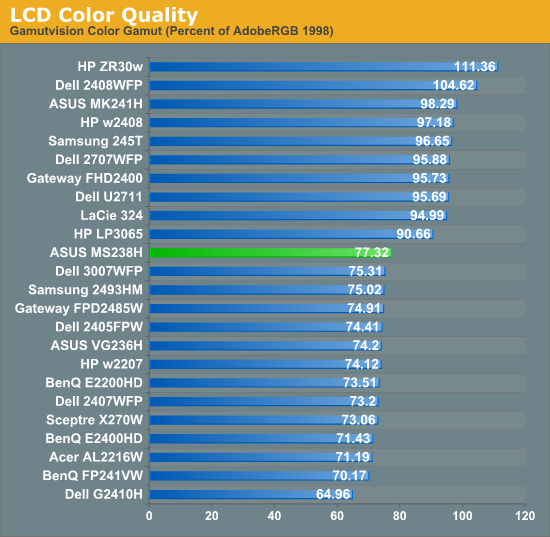
When it comes to gamut, the MS238H actually leads our stairstep-pattern of display results. Gamut could be better if the MS238H had RGB LED backlighting instead of WLED, but again this is a budget monitor with slim profile and power-sipping priorities.
Color Uniformity
Now for color consistency, we take our best calibration profile from the very center at 200 nits and test color accuracy at 9 different places around the LCD display in an evenly distributed grid. We’ve shown before that calibration is actually very localized across the display, partly due to the brightness not being uniform, partly due to the discrete nature of the LCD panel itself.
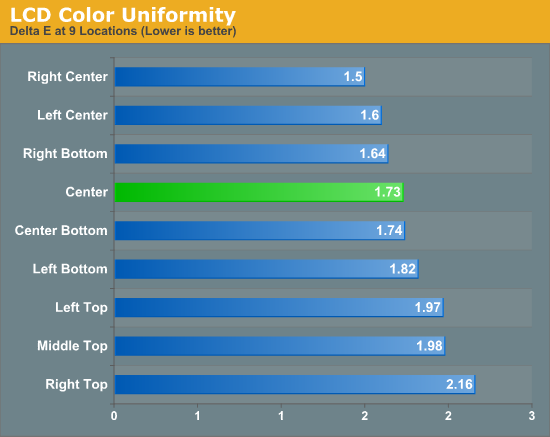

More and more we can see just how localized display calibration really is. The MS238H keeps Delta-E under 2 everywhere but the top right, where it spikes up to 2.16. We're still getting a feel for how these measures compare across displays, but this display manages to keep performance relatively consistent. What's strange is that Delta-E actually improves outside of the center, despite the profile being made in the center - I'm honestly baffled as to how right-center can be the absolute best. The only explanation is that brightness rolls off in those regions, as we'll show in the brightness uniformity section.
Brightness and Contrast
For brightness we display white and black levels at maximum and minimum brightness as allowed by the OSD, and divide the two to get contrast. We use the same colorimeter described earlier. In this case, an Xrite i1D2 with ColorEyes Display Pro.
Again the MS238H packs WLED backlighting so settle time after brightness changes and power-on isn't very long, on the order of just a few minutes instead of the usual half hour to 45 minutes for CCFL backlighting.
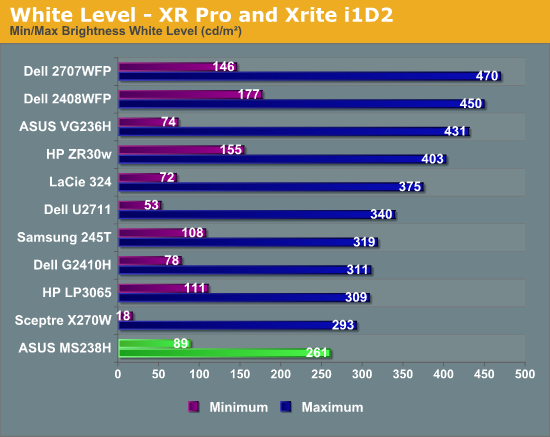
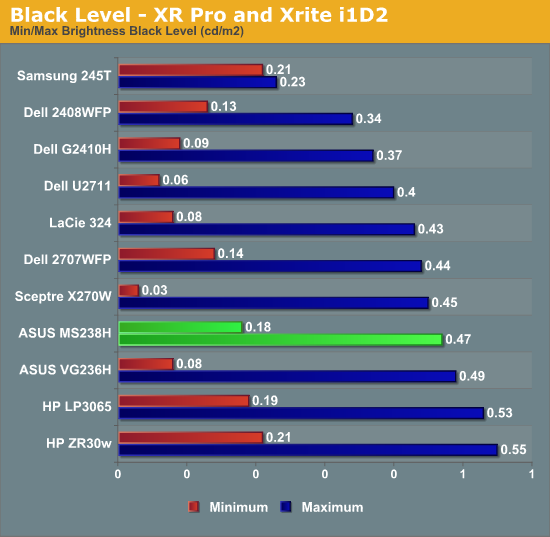
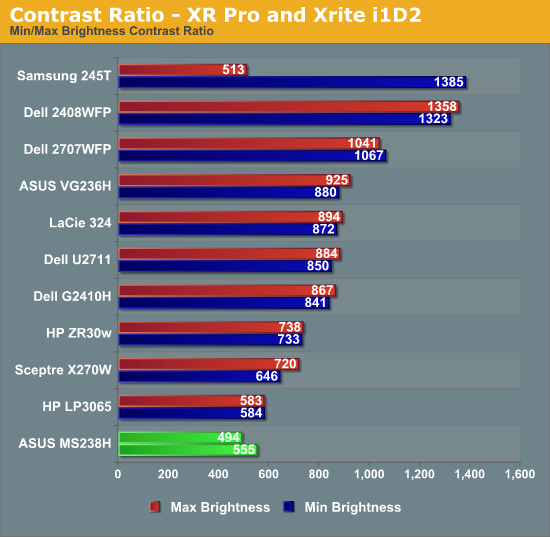
This is probably the only considerable weak point in the MS238H performance. Brightness isn't stellar at all, peaking at 261 nits, with a minimum of 89 nits. Again, it's clear that power savings, cost, and profile were the chief concerns here, and all that means fewer backlight LEDs. Blacks are middling - I'm a bit disappointed the black level at 89 nits isn't better, and contrast as a result suffers all around at around 560. I used the MS238H for a long time and didn't really ever find myself want for more contrast, but it just isn't a star performer on paper here.
Brightness Uniformity
For brightness uniformity, we test at the same 9 points we measure Delta-E on, but this time measure white and black levels when the center point is as close to 200 nits as we can get. We use the same colorimeter and software as before, - an Xrite i1D2 and ColorEyes Display Pro.
Brightness Uniformity - White
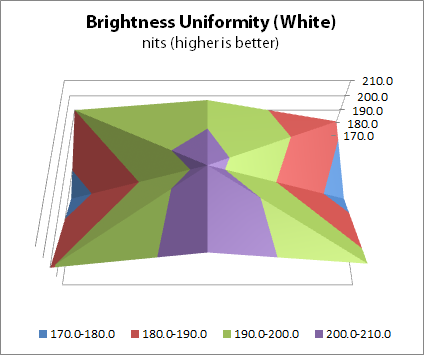
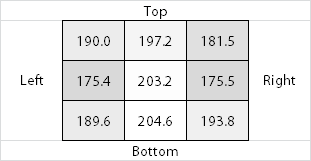
Brightness Uniformity - Black
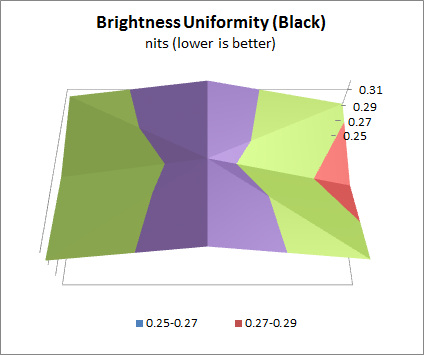
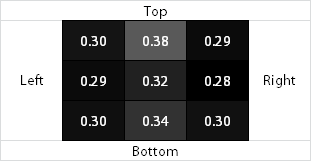
Our plots exaggerate things, but there's some noticeable rolloff in the horizontal direction across the display, both in black and white levels. In the complete dark, at maximum brightness, there's a bit of light leakage at the very bottom and the far left. It is very hard to detect in actual use, but in complete darkness displaying nothing but black, it's there.
Processing and Input Latency
Processing and display lag is a very important thing for gamers, and it’s most often nebulously reported if at all. We’ve discussed this in previous display reviews, but what matters most is how the display acts in real world testing. I’ve been doing previous tests by comparing LCDs with first a 17” Princeton CRT, then a Sony G520 20” CRT. So far the results have been a bit interesting, with the CRTs edging a pretty consistent - if small - lead over LCDs.
I measured the MS238H the same way we've done it for a number of displays now, by snapping many photos of the same wings of fury 3DMark 2003 demo mirrored on the CRT and LCD. Average a ton of results from those images, and we get a feel for what input latency works out to.
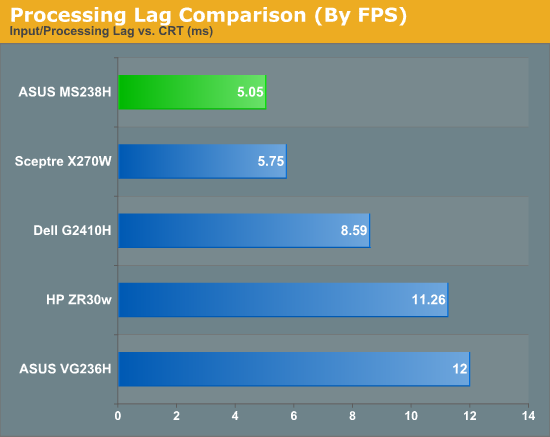
The MS238H actually leads here, edging out the TN-packing Sceptre X270W and G2410H. It shouldn't surprise that a no-frills TN can post good numbers in the latency department. We still see that ever-persistent one frame of residual image on the MS238H, but that's typical.
Again, I played a lot of FPS and console games on the display and didn't detect any lag, if anything the comparison with my home theatre system made me realize just how laggy the combination of A/V receiver (even in game mode) and TV (also in game mode) feels. Perhaps we'll investigate that someday soon.
Power Consumption
The ASUS MS238H specifications note that power use is typically under 33 watts. We measure with a Kill-A-Watt at the wall after the power adapter. Thankfully our measurements confirm and exceed that number, with a maximum draw at max brightness of 27 watts, and minimum draw of 15 watts at minimum brightness.
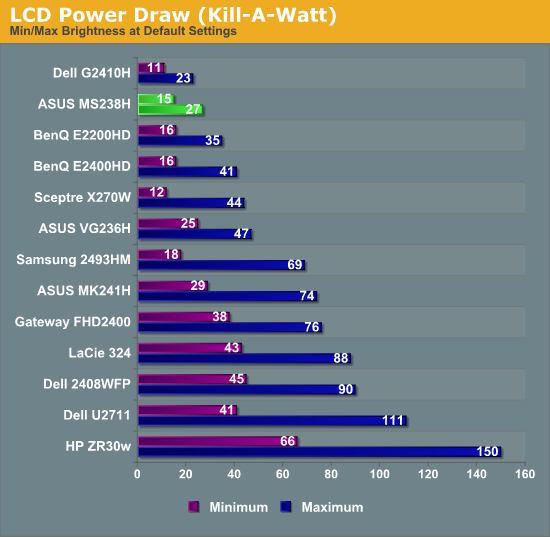 ;
;
The MS238H still can't quite best Dell's green-focused G2410H though, but what's a difference of 4 watts among friends? I mentioned earlier that the MS238H lacks an internal power supply - no doubt this is done to keep the profile as thin as possible. Instead, there's an external DC adapter.
Conclusions and Final Thoughts
I spent an almost embarrassingly long time with the MS238H, and on the whole I came away pretty impressed with the display. It isn't as flashy or feature-packed as the IPS panel displays we're used to tackling, but what it does, it does well. For $170, you get a 23-inch 1080P display with HDMI inputs that's slim and lightweight, with the added bonus of a 3.5mm headphone jack for HDMI audio and an all around eco-friendly package. Color quality isn't bad after calibration, and if you can live without height and pivot adjustments and a limited range of tilt, the minimalist and unique stand the MS238H uses is actually pretty novel. Overall the whole display is a mainstream package - it's priced accordingly and doesn't really have any extras beyond such a unique industrial design.
That isn't to say the MS238H isn't without some things that could use improvement. We've been beating this dead horse for a while now, but the explosion of 1920x1080 displays seems to have completely killed the old 16:10 1920x1200 display segment. In that regard, display manufacturers have actually taken a step backward in realizable resolution, but that's something essentially every manufacturer is guilty of. Other gripes are the high-gloss surface treatment for the display's bezel and cladding. It shows dust, and will build up static that attracts more dust if you don't wipe it with the right kind of cloth. If you're resting the display on a slick surface like glass, there's also the chance the stand will drift into the most reclined tilt position possible. Finally, I'd like to see another digital connection instead of VGA, be it DisplayPort, another HDMI port, or DVI-D. Additionally, it'd be nice if the MS238H got a tad brighter, even though 200 nits is totally reasonable for most work. Likewise, contrast rounds out the bottom of the pack.
The 23" mass market 1080P segment is definitely getting crowded, with prices ranging from $150 to $300 for displays with similar features. That said, for its price and featureset, I could really see the MS238H being useful as an easily transportable LAN party display for PC and console gamers alike. It's seriously thin and light, simple, inexpensive and doesn't require a lot of surface area. What more is there to want?

